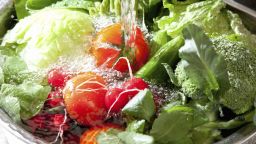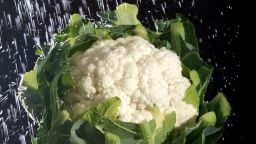Story highlights
Cooking vegetables can release nutrients and boost antioxidant capabilities
Maximize nutrition by matching the cooking method to the vegetable
Good defaults are steaming and microwaving
Whether you love vegetables or not, there’s one thing you know for sure: Veggies are really good for you. And you can make them even more nutritious if you prepare them in ways that maximize their benefits.
Oddly enough, that’s not likely to be raw. Studies show the process of cooking actually breaks down tough outer layers and cellular structure of many vegetables, making it easier for your body to absorb their nutrients.
For example, compared to raw, “studies found that eating cooked spinach and carrots resulted in higher blood levels of the antioxidant beta carotene, which then converts to vitamin A,” said registered dietitian Elaine Magee, author of “Food Synergy: Unleash Hundreds of Powerful Healing Food Combinations to Fight Disease and Live Well.”

And it’s not just limited to vitamins, Magee said. “Cooking vegetables also helps increase the amount of minerals, like calcium, magnesium and iron, available to the body,” she said.
Steam, don’t boil
As a general rule, it’s best to keep cooking time, temperature and the amount of liquid to a minimum. That’s why steaming is one of the best ways to cook most vegetables. It turns out that’s especially true for broccoli, long touted as one of our top anti-cancer foods.
“When buying fresh broccoli, look for firm florets with a purple, dark green, or bluish hue on the top,” Magee said. “as they are likely to contain more beta carotene and vitamin C than florets with lighter green tops.”
A 2009 study prepared broccoli using five popular methods – boiling, microwaving, steaming, stir-frying and stir-frying/boiling. Researchers found steaming kept the highest level of nutrients.
“Boiling vegetables causes water soluble vitamins like vitamin C, B1 and folate to leach into the water,” Magee said. “So unless you are going to drink the water along with your vegetables, such as when making soups and stews, these vitamins are typically poured down the sink. Steaming is a gentler way to cook because the vegetables don’t come in contact with the boiling water.”
Another 2009 study found peas, cauliflower and zucchini to be particularly susceptible to a loss of nutrients through boiling, losing more than 50% of their antioxidants. “Water is not the cook’s best friend when it comes to preparing vegetables,” the researchers summarized.
But what’s a rule without exceptions? In this case, it’s carrots. Another study showed both boiling and steaming increased levels of beta carotene. But try to cook carrots whole, as cutting can reduce nutrients by 25%.

In fact, cooking veggies whole is often the best choice to preserve nutrients. When that’s not practical, be sure to cut them into large uniform pieces that will cook evenly. And wait to wash your vegetables until just before you cut – washing before storing may promote bacterial growth and speed up spoilage, Magee said.
When in doubt, microwave
Microwaving uses little to no water, and can heat the veggie quickly from within, preserving nutrients such as vitamin C that break down when heated. A 2003 study found significantly higher levels of phytonutrients in zucchini, carrots and beans cooked with minimal water. Phytonutrients are compounds naturally found in plants that provide health benefits and disease protection in the human body.

Another exception: Don’t microwave cauliflower. The 2009 Spanish study found the highest losses of nutrients in cauliflower after boiling and microwaving.
Saute, don’t fry
Studies show that during deep-fat frying, fat penetrates the food and vegetables dehydrate. But sauteing in a bit of healthy cooking oil, such as extra-virgin olive oil, is a great way to cook many vegetables. Not only does it maximize flavor, but the addition of olive oil “appears to increase the absorption of phytonutrients like phenols and carotenes,” said Magee, who is also the corporate dietitian for the grocery firm Albertsons Companies. That’s because many of the vitamins and nutrients in vegetables are fat soluble, meaning your body absorbs them better in the presence of fat.
A 2015 study linked sauteing certain highly popular Mediterranean vegetables, such as eggplant, in extra-virgin olive oil with an increase of antioxidants that can protect against cancer.

Olive oil is a great option for sauteing because it has one of the highest levels of antioxidants and phytonutrients of the cooking oils. While olive oil has a lower smoke point than canola, Magee said, “when sauteing, you control the temperature that food is cooked at, so you can avoid the higher temperatures.”
‘Griddling,’ baking and roasting
Contrary to grilling, which normally involves some sort of charcoal, “griddling” uses a pan with distinctive raised edges and is normally done on the stove or in the oven.
Veggies griddled with a tiny bit of olive oil can develop intense flavor and be quite healthy. The 2009 Spanish study found it to be an especially good choice for green beans, asparagus, broccoli, celery, onions, Swiss chard and onions.
Baking or roasting is hit-or-miss, and very dependent on the vegetable.
“Oven temperature, time and the specific vegetable determines the vitamin content,” said Magee. “Nutrient capacity will decrease a bit with some vegetables while access to certain nutrients may go up with others.”
The 2009 Spanish study found artichokes, asparagus, broccoli, celery, eggplant, green beans, onions and spinach kept their antioxidant capacity after baking. Green peppers lost antioxidant capacity.

Tomatoes are also served well by roasting – and cooking in general. Studies show that cutting and heating tomatoes opens up the cell wall of the fruit (and tomatoes are technically a fruit), which allows greater access to the health benefits of the antioxident lycopene. Adding a bit of healthy fat, such as olive oil, helps as well.
“Lycopene fights a range of diseases,” said Magee. “The fat-soluble red pigment found primarily in tomatoes is thought to have the highest antioxidant activity of all the carotenoids and antioxidant compounds, and may reduce the risk of an assortment of diseases, from Alzheimer’s to cancer.”
Maximize that benefit, Magee added, by never peeling a tomato or throwing away it’s seeds. “Most of the antioxidant power of the tomato actually lies in the peel and seeds,” Magee said, “so the best way to cook fresh tomatoes is au naturel.”
But if you hate tomatoes don’t rush out and buy a lycopene supplement, Magee warned. “Overall, the evidence of lycopene’s anti-cancer effect is more evident in people who eat plenty of tomato products than in those who take supplements.”
Best method to use?
So, which cooking method is best? The answer often depends on the vegetable. If you’re a dedicated cook, staying on top of the latest science might be helpful.
“As researchers have begun to see patterns emerge that show how various food components and cooking methods actually work together to yield even greater health benefits,” Magee said, “the study of nutrition has been taken to a higher level. It’s almost as if a new language is being spoken.”
But Magee added that for days when you’re too busy to look up the latest research, here’s how to boil it down (so to speak): Default to steaming and microwaving with just a little bit of water, throw in a splash of olive oil when you can, and your veggies – and body – will thank you.












